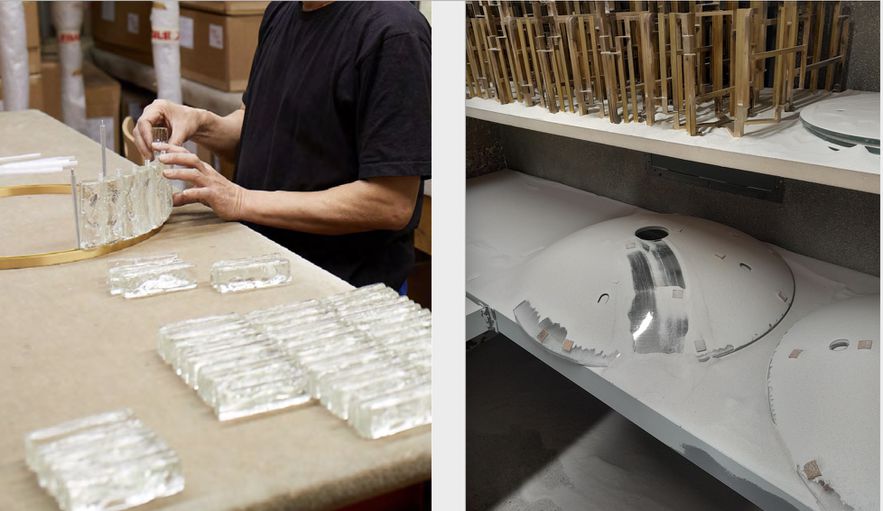It’s the story of a little guy from Bavaria, promoted “prince of modern light” in the Paris of the Roaring Twenties. A consecration for the native of Bruck, Germany, who was born there in 1892 under the surname of Joseph Perzl. Son and grandson of a glassmaker, he was only 14 years old when he trained in Munich in the family know-how, before undertaking a tour of Europe on foot, during which he perfected himself in the centuries-old techniques of his art. From Austria to Northern Italy, via Czechoslovakia and Switzerland, he ended up reaching France, his future chosen homeland.
Engaged in the Foreign Legion during the Great War, he was naturalized French at the end of the conflict. Joseph Perzl, who became Jean Perzel, then worked as a master glassmaker with Jacques Grüber, a renowned stained glass artist from the Nancy school, from whom he drew inspiration to design his first lights with reinforced lead frames. In 1923, the young thirty-year-old opened his own studio, soon to be located at 3 rue de la Cité-Universitaire, in Paris, on the edge of Parc Montsouris, in a bespoke Art Deco building built by the modernist architect Michel Roux-Spitz.
Lamp no. 817 has become part of French heritage. To dr. : wall lamp n° 347 B bis, which lit up “Normandy” in the 1930s.
/ © Ateliers Jean Perzel
While the 1920s saw the emergence of Art Deco, which would revolutionize the design and architecture of the 20th century, the electricity fairy came into homes. Perzel is passionate about this new energy, of which he is the first designer to care about the nature and the means of use. He works on indirect or semi-direct light, then designs decorative supports in harmony with the diffusing mission of glass. He tirelessly studies the laws of optics and its concrete impact on lighting to highlight the environment and faces through the intensity and color of light, amber, delicately pink or champagne. His obsession: to seek soothing effects for the eye. An unprecedented concern in the luminous sphere which until then had used this energy without rule or measure.
The fashionable architects and decorators of the time – Le Corbusier, Mallet-Stevens, Ruhlmann, Leleu – were not mistaken and called on his talents. Prestigious orders rain down: the court of the King of the Belgians, the liner Normandy, the League of Nations in Geneva, the Cathedral of Luxembourg… They are also found in the homes of Baron Robert de Rothschild and Henry Ford. For the latter, on the occasion of the completion of the 25,000,000th car of the brand, François Raidt, the nephew of Jean Perzel who joined the company, designed in 1937, at only 18 years old, lights inspired by gears famous cars. In 1951, François took over the management of the workshops before handing over the reins to his son Olivier in 1994.

The pieces are entirely shaped by hand using the techniques introduced by the founder in the 1920s.
/ © Ateliers Jean Perzel
Meanwhile, Jean, the brilliant founder, died at the age of 94, reassured about the durability of his house. Embracing three generations, it remains a craft company disdaining mass production in favor of timeless craftsmanship. “Each piece, whose elements are shaped and assembled manually, can require up to 95 hours of work. It’s haute couture, the enhancement, not of the object itself, but of the specific environment that will welcome him”, underlines Olivier Raidt, himself trained at this school of rigor by his father.
Today, on rue de la Cité-Universitaire, in the basement of the showroom, a dozen companions of duty continue to produce the brand’s icons by hand, such as the wall lamp n° 347 B bis, this bronze, underlined by strips of frosted glass hand-cut with a diamond, which illuminated the smoking room of the Normandy in the 1930s. Or the desk lamp, numbered 817, devilish Art Deco, bought by the Mobilier national. Yet another demonstration of the entry into the French heritage of the Perzel signature, which has not finished enlightening the universe of aesthetes.
To read : Jean Perzel workshops. Light efficiency, by Jean-Jacques Wattel. Editions Louvre Victory, €70.
